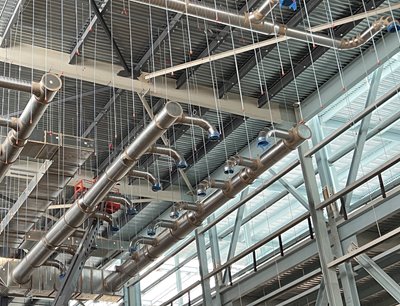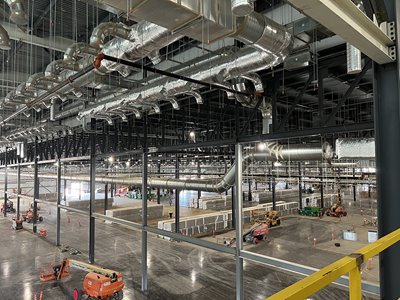Poynter Sheet Metal of Greenwood, Indiana is part of one of the largest construction projects in United States history, which is transforming a small town. “It had a gas station and some people living in what they thought was a remote area,” says Joseph Lansdell, president of Poynter Sheet Metal in Greenwood, Indiana. “Now it's going to be an absolutely huge Electrical Vehicle battery manufacturing facility.” Each of the two main buildings will be about four and a half million square feet. “Overall, there are 13 outbuildings, which brings the facility to 10 million square feet.”
Matt Cramer, president of Dee Cramer, Inc. in Holly, Michigan learned about the massive project in late 2021 through his long-standing relationship with Barton Malow, a Michigan general contractor. Cramer asked Poynter to consider handling the project as a joint venture. After an interview process, Barton Malow’s client invited Poynter to join the team. Poynter has over twenty years of experience with automotive facilities, but their pharma resume was more important to this project. “We've done projects for Tesla down in Austin and worked with GM in Tennessee, but this is a battery producing factory,” Lansdell says. “A battery requires a super clean, super dry environment. It looks like a cleanroom we would do for a pharmaceutical facility.”
As they worked through the planning process, Cramer encouraged Poynter to take the lead. “I told him we will provide whatever pre-con and upfront support in design and estimating they need, so that's how we did it,” Cramer says. “Poynter’s doing an incredible job.”

On this project, Poynter used roughly 250 tradespeople onsite,
and the project will total several hundred thousand shop work
hours.
Poynter and Cramer worked with the owner and designers throughout 2022. “We put in several estimates to build the price and budget with the owner,” Lansdell says. “If you weren't in Michigan, you were in Zoom meetings that went four and five hours long. Probably the biggest input we had was in the schedule detail.” Poynter recommended changes in the way the job flows to match sequences. “We also went through estimates in front of the client’s people and an audit team. With that level of trust from the owner, we had to expose everything line by line to explain and support what we meant by our estimate.”
Poynter’s uses products like Autodesk’s Revit and CADmep to draw and plan the work. “CADmep is tied to our estimate, to our detailing, and to our productivity in the shop,” Lansdell says. “We use Bluebeam, we track 100% of our install using virtual tracking, and we have tablet technology in the field.”
Poynter mobilized to the site in the fourth quarter of 2022 and started installation that December. “In the field, we have a full office staff with their own comptroller, payroll clerks, accounts payable, accounts receivable, project managers, project engineers and safety staff,” Lansdell says. “We’ve treated it like its own company. We have college age students working in our project engineering and project management staff, and we took key people out of our office in Louisville, Kentucky.” Brian Neal, Poynter’s executive vice president, oversees the facility.
Each of the twin production plants is almost a mile long, so the sheer scale is the biggest challenge. “There’s over four million pounds of ductwork per building,” Lansdell says. “We are fabricating 100% of that in our 160,000 square foot shop.” The shop day shift has grown to 120 people with a smaller night shift of 30-40 people. “We have three lasers dedicated just to ventilation cutting.” They are purchasing some items, like 16,000 round elbows.
Poynter is responsible to set all air handling equipment, a huge commitment with 32 coater oven air handling units, 128 building air handling units, 90 direct heating units, and 384 fans. The project will bring Poynter several hundred thousand shop workhours, several hundred thousand field workhours, and 50 to 60,000 hours of detailing time.
Poynter has about 250 tradespeople on site. “We've had good success recruiting as far as 75 miles away,” Lansdell says. “Because we've onboarded new workers, we set up classes on site to teach simple skills like how to seal the network properly. It's really helped our quality.”
Attendance has been a surprise challenge. “We are working six days a week and ten hours a day on this project, and we have other jobs going at the same time,” Lansdell says. “We have several workers who travel 50 miles to work each day, then go home. Working 6/10s for an extended period really wears on people, so that's been a nuance we didn’t think about when we started. We’ve had to plan for a certain level of absenteeism, especially for the workers who are traveling.”
